Role of Leadership in Staff Development
| ✅ Paper Type: Free Essay | ✅ Subject: Leadership |
| ✅ Wordcount: 2655 words | ✅ Published: 23 Sep 2019 |
Contents:
Part A: The role of leadership in staff development pg. 3-5
Part B:
Rationale………………………………………………………… pg. 5-6
Individual goal setting………………………………………. pg. 6-7
Individual development plans……………………………. pg. 7-8
Group goal setting…………………………………………… pg. 8
Action plan…………………………………………………….. pg. 8-9
Evaluation……………………………………………………….. pg. 9
References………………………………………………………. pg. 10-11
Appendix………………………………………………………….. pg. 12-16
Part A: The Role of Leadership in Staff Development
Leadership in early childhood settings is one of the most important factors in determining optimal conditions for children’s growth, development and learning. Staff development improves the overall attitudes, knowledge and skills of all involved as it provides opportunities to practice new and existing skills, and receive/provide immediate feedback (Fukkink & Lont, 2007). The early childhood sector is ever changing and progressively growing to meet the needs of the current curriculum, so it is important that leaders within early childhood settings are adapting alongside it, and can therefore guide and support proper and helpful staff development.
The National Quality Standards place a large emphasis on effective leadership, particularly in Area 7: Governance and Leadership. This standard states it’s aim as; ‘to support effective leadership and management of the service that contributes to quality environments for children’s learning and development. Well-documented policies and procedures, well-maintained records, shared values, clear direction and reflective practices enable the service to function as a learning community’ (ACECQA, 2018). Leaders refer to this standard in their work to improve the centre and put into action, with help from staff, steps to achieve the overall vision from all staff for the best outcome for the centre. They provide a focus on professional development, give staff opportunities for professional growth, and create clear policies that help meet the needs of children and staff (Waniganayake, Cheeseman, Fenech, Hadley, & Shepherd, 2012).
A leader in an early childhood setting should use distributed, mentoring and authentic leadership styles as these are the most common and effective approaches to implement in early childhood settings, including in staff development situations. Distributed leadership has a significant role in early childhood settings due to the high number of staff and responsibilities that are shared (Clarkin-Phillips, 2007). Distributed leadership is described as multiple people taking responsibility for multiple different tasks (Spillane, 2012). The benefits of this type of leadership are, due to multiple staff members being in a room at once, they can work together to plan and share tasks, which provides more opportunities for in-depth and effective learning experiences for students. Research has suggested that distributed leadership allows staff to take on new roles, which ultimately strengthens the working environment as staff are more motivated, challenged and engaged (Clarkin-Phillips, 2007). Staff development would benefit as a result of the use of distributed leadership as it provides opportunities for teachers to have greater participation in their allocated roles and contribute their strengths through common practices.
The leadership style ‘mentoring’ is defined as an individual who is experienced in a field, building a relationship with another less experienced individual to extend on their skills and knowledge (Ebbeck & Waniganayake, 2002). Mentoring is a useful leadership strategy as it allows for further support, guidance and information that may be required by staff members. The benefits of taking on the mentor role as a leader and having a mentoring group within an early childhood setting, builds a more comprehensive and effective working environment where ultimately communication and good listening skills are established (Aubrey, 2011). Mentoring can support staff development through informal and formal training, where they develop and learn to understand the roles and responsibilities that are required of them (Rodd, 2013) while also building meaningful, productive relationships with co-workers.
Authentic leadership works in guiding the process of positive change by providing opportunities for staff-wide participation and for building strong relationships (Rodd, 2013). Authentic leadership promotes honest and open communication, embraces collaboration for development and aims to realise what needs to happen in the moment (Rodd, 2013).. Authentic leaders put the goals of the centre before their own, and adjust plans to better meet the needs of others (Moore, 2017). Staff development is valued and strengthened, as individual staff feel appreciated and supported in their workplace.
Effective leadership is critical in motivating staff to reach their full potential and provide the best learning experience/environment for the students within the centre. All leadership styles involve deliberate and constant, face-to-face staff development. A leader should work towards the goal to implement the best possible practice to meet the needs of as many individuals within the early childhood setting’s community as possible.
Part B: Rationale
Leadership within early childhood settings involves influencing staff to work to achieve shared goals (Rodd, 2013) on policies, procedures and every day practices. To engage staff in ongoing professional development, a leader should promote an honest and open communication policy in the workplace while using appropriate leadership styles to uphold this. The distributed and mentoring leadership styles are used in the focus early childhood setting of this report– Care Bear Childcare (pseudonym).
At Care Bear Childcare (CBC), their aim is to give children the best start in life and provide each child with educated and motivated staff, who are eager and prepared to enhance their student’s learning. It is important to those leading CBC to form strong and open relationships with the entire community, including families as well as their own staff, as all are an important part of developing an environment that is best for children’s needs.
CBC has used ‘distributed leadership’ within the centre, and as a result staff have been able to see their contributions being more often noticed and more highly valued, which has made for a happier and more successful learning environment (Clarkin-Phillips, 2007). The use of mentoring has also allowed for a more personalised input from the leader to support the staff – again achieving positive outcomes in the workplace for all.
In order to implement the best approaches to enhance staff development, CBC was sure to refer to the Early Years Learning Framework (EYLF) and the National Quality Standards (NQS) as a basis for the leadership styles used. The EYLF aims to inspire conversations and improve communication amongst individuals to form the foundation for ensuring that children in all early childhood education and care settings throughout Australia experience quality teaching and learning (DEEWR, 2009). One of the 5 EYLF principles is ‘ongoing learning and reflective practices’ which states that educators should continually improve professional knowledge and learning practices, value the local knowledge of families and the community, and engage in ongoing learning of philosophy, ethics and practice (DEEWR, 2009). Hard (2005), highlights the importance of meaningful interactions among leaders and staff as highly valuable in supporting professional learning/staff development. Those in leadership roles at CBC valued the importance of guiding and supporting staff in endeavours to gain knowledge and improve practice through leadership practices, creating a space for optimal staff development. The NQS Standard 7: Governance and Leadership, states how an educational leader is responsible for leading the development of program and assessment, and that staff should be regularly evaluated on their performance and plans (ACECQA, 2018).
Referencing the EYLF and NQS, I have formulated CBC’s staff development plan, which aims to increase staff engagement and enhance staff’s motivation to seek out learning opportunities through a more open communication policy and more frequent feedback.
Individual Goal Setting
The Individual planning conference for CBC was held with two staff members – Sue and Polly. The aim of this conference is to identify their professional goals, as well as highlight their strengths (appendix item 1&2). A planning conference is designed to engage staff in meaningful communication which allows for an awareness of each other’s views and values (Hard, 2005). The conference began with a problem-solving technique, where in which staff were asked to consider and discuss areas in need of improvement within the centre. This allowed for issues to be openly discussed and strategies to eliminate these issues could be put forward. A goals template was then filled out by Sue and Polly which included the headings: strengths as a teacher, identified growth areas, and goals/objectives. Both Sue and Polly identified different strengths and objectives, and both agreed on the need for growth in the area of behaviour management.
Sue put forward the goal of developing more creative programs that could cater for students with behavioural issues. Together, we came up with the following 3 objectives for this goal:
- Discussing her ideas with other staff members to gain knowledge and build upon her program;
- Developing more effective and individualised behaviour management strategies for students, and;
- Researching for support services in the surrounding area.
Polly’s goal was to develop and maintain a more positive and collaborative workplace. The objectives we developed to achieve this goal included:
- Increased reflection on daily practices;
- Developing projects for the centre that can spread amongst different playrooms, and;
- Placing a larger focus on finding ways to boost effective collaboration.
By using mentoring and problem solving in the leadership approach, it has allowed for more trusting and engaging open communication. This proceeded to create a space for all involved to decide on realistic goals collaboratively.
Individual Development Plans
A meeting was scheduled a week following the individual planning conference to discuss Sue and Polly’s individual staff development plans. The NQS quality standard 7, standard 7.2: Leadership, element 7.2.3: Development of professionals, highlights that educators, co-ordinators and staff members’ performance should be regularly evaluated and individual plans should be put in place to support learning and development (ACECQA, 2018). This meeting was held in order to reflect on the goals and objectives set previously and add further detail to them in creating the Goals Blueprint templates (appendix item 2). Throughout the discussion, I as the leader was sure to incorporate active listening skills as part of the mentoring approach, which led to an atmosphere that was engaged and thoughtful in providing feedback on the objectives being discussed (Hoppe, 2006). It is crucial for leaders to monitor and review individual’s work to deliver feedback and positive reinforcement (Brundrett, Burton and Smith, 2003) to create a supportive environment, and increase staff satisfaction when developing appropriate steps for their objectives.
Group Goal Setting
Based upon the planning conference and development plan information, it was found that Sue and Polly shared a similar idea – both of their objectives highlighted the need for more effective collaboration strategies. Within early childhood settings, communication is exceedingly important due to the large amount of staff working in such close proximity, following ever-changing policies/procedures. Waniganayake (2012, p. 159), states that communication is key to successful leadership relationships. Providing effective strategies to form an envoironment where staff feel comfortable and confident to openly and honestly communicate with others will ensure all staff are well informed and can express ideas on how to overcome issues that may arise. Polly emphasised the usefulness of reflecting on daily practices, so through effective discussion it was concluded that all staff will take part in individual room meetings for reflection and shared feedback (Waniganayake, 2012). This will help in providing an open environment to discuss ideas – such as Sue’s need for discussion of her objective area: creating better behaviour management strategies. These group goals align with CBC’s philosophy of maintaining an environment that builds strong relationships through trusting and open communication for the benefit of all involved – especially the children.
Action plan
The individual goals blueprint, planning conference and the staff development have provided enough information to consider to produce an action plan. The main issue that arose during these steps with Sue and Polly was a need for more effective ways to collaborate. The distributed leadership approach was used in the planning of this action plan, in order to allow all staff to be actively involved in the process. The objectives designed to amend this issue are as follows:
The objectives are (appendix item 4):
- To increase staff’s knowledge of how to effectively communicate in the workplace;
- To encourage more regular feedback and reinforcement for effective planning, and;
- To increase staff inclusion through regular room meetings.
The NQS and the EYLF both promote the importance of interactions among all levels of staff for success. Leadership is a shared body of knowledge which together with a set of educational values, will help guide professional practice to success (Brundrett, Burton and Smith, 2003). The action plan has been presented to all staff at CBC through collaborative discussion and individual mentoring at the monthly staff meeting. All staff members have signed to ensure their commitment to following up on this action plan.
Evaluation
Staff development is a continually helpful tool for early childhood settings to function at their best as it works in ensuring staff are always reaching their full potential – and therefore providing the best experience for all involved. The individual staff development plans and the setting-wide action plan have allowed for issues to be raised and amended. The use of mentoring, active listening, problem solving, and distributed leadership were used as the basis for the implementation of the action plan, and in encouraging/supporting staff to undertake working towards their individual goals. As a result of more consistent and frequent interactions between staff members and more constructive communication through ongoing feedback, the staff at CBC are more willing to share ideas and help one another to build improved programs.
The implementation of an appropriate leadership style promotes an engaging and highly motivated learning environment. Clarkin-Phillips (2011) states that centres engaged in a professional development program developed and supported individual strengths and had a more involved shared vision which benefitted staff, children and families – leading to an improved centre overall.
References
- Aubrey, C. (2011). Leading and managing in the early years (2nd ed.). London: Sage Publications
- Australian Children’s Care and Education Quality Authority (ACECQA) (2018). Guide to the National Quality Standard. Retrieved from: http://files.acecqa.gov.au/files/National-Quality-Framework-Resources-Kit/NQF-Resource-03-Guide-to-NQS.pdf
- Blase, J. (1999). Leadership for Staff Development: Supporting the Lifelong Study of Teaching and Learning. Retrieved from https://eric.ed.gov/?id=ED439123
- Brundrett, M., Burton, N., & Smith, R. (2003). Leadership in education. Sage.
- Clarkin- Phillips, J. (2011). Distributed leadership: Growing strong communities of practice in early childhood centres. Journal of Educational Leadership, Policy and Practice (pp. 14-25).
- Department of Education Employment and Workplace Relations (2009). Belonging, being & becoming: The Early Years Learning Framework for Australia. Retrieved from http://education.gov.au/early-years-learning-framework
- Ebbeck, M., & Waniganayake, M. (2002). Early childhood professionals: Leading today and tomorrow. Elsevier Australia.
- Fukkink, R. & Lont, A. (2007). Does training matter? A meta-analysis and review of caregiver training studies. Early Childhood Research Quarterly, 22: 294–311.
- Hard, L. (2005). How is Leadership Understood and Enacted within the Field of Early Childhood Education and Care? Retrieved from http://eprints.qut.edu.au/16213/1/Louise_Hard_Thesis.pdf
- Hoppe, M. (2006). Active listening: improve your ability to listen and lead. Centre for Creative Leadership.
- Moore, B. (2017). Authentic Leadership: Applications in Academic Decision-Making. In Comprehensive Problem-Solving and Skill Development for Next-Generation Leaders (pp. 76-94). IGI Global.
- Robbins, S., Millett, B., & Waters-Marsh, T. (2004). Organisational behaviour. Sydney: Pearson Education.
- Rodd, J. (2013). Leadership in early childhood (4th ed.), pp. 63-74 and pp. 166-181. Sydney: Allen & Unwin.
- Spillane, J. P. (2012). Distributed leadership (Vol. 4). John Wiley & Sons.
- Waniganayake, M., Cheeseman, S., Fenech, M., Hadley, F., & Shepherd, W. (2017). Leadership: Contexts and complexities in early childhood education (2nd ed.). Melbourne: Oxford University Press.
Appendix
- Preparing for the Planning Conference

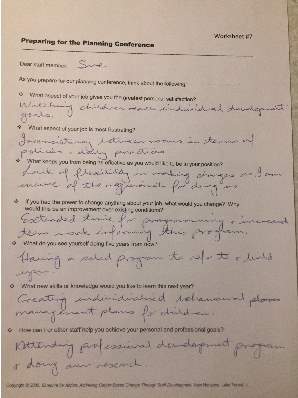
- Goals Blueprint
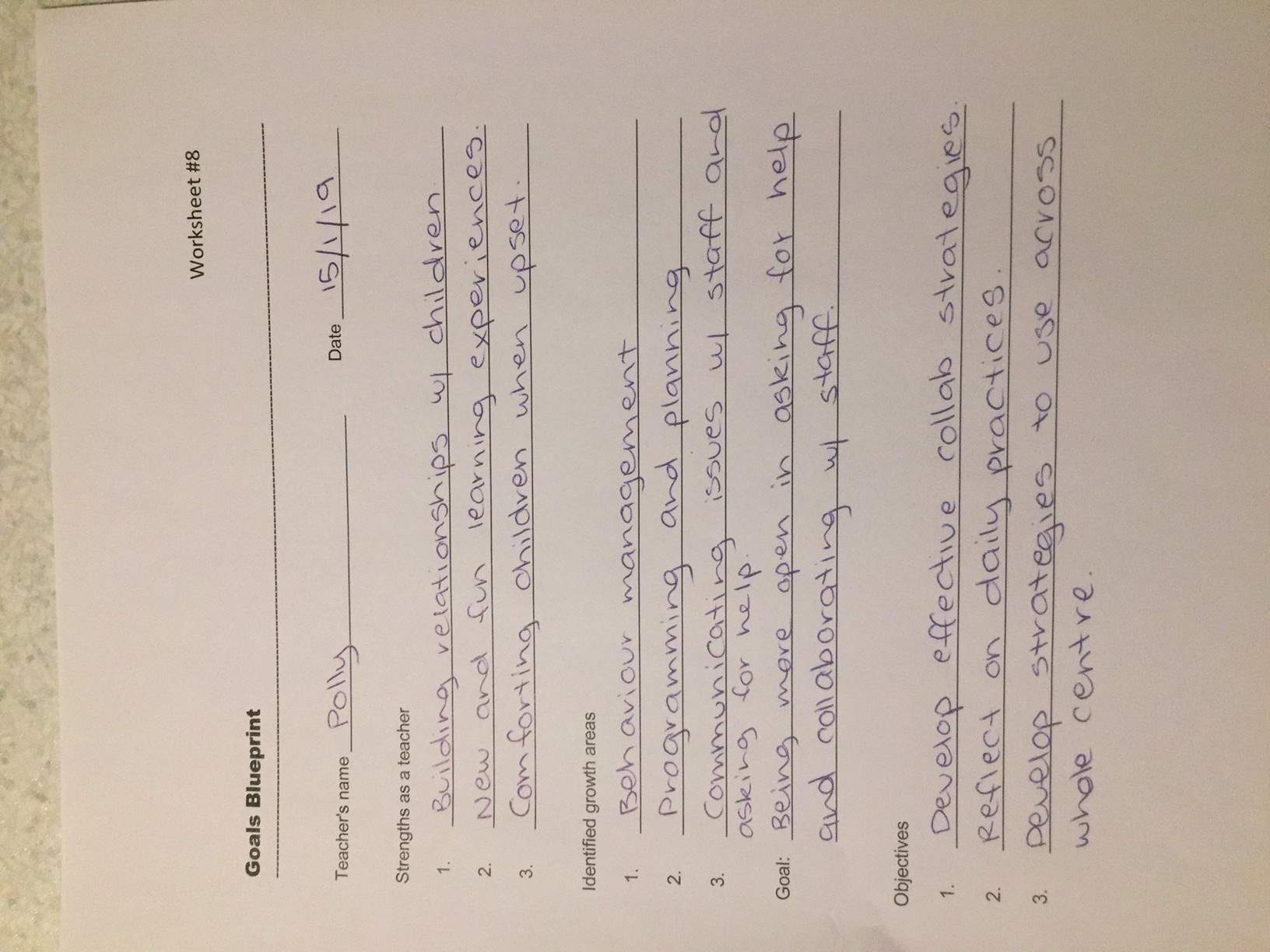

- Staff Development Action Plan
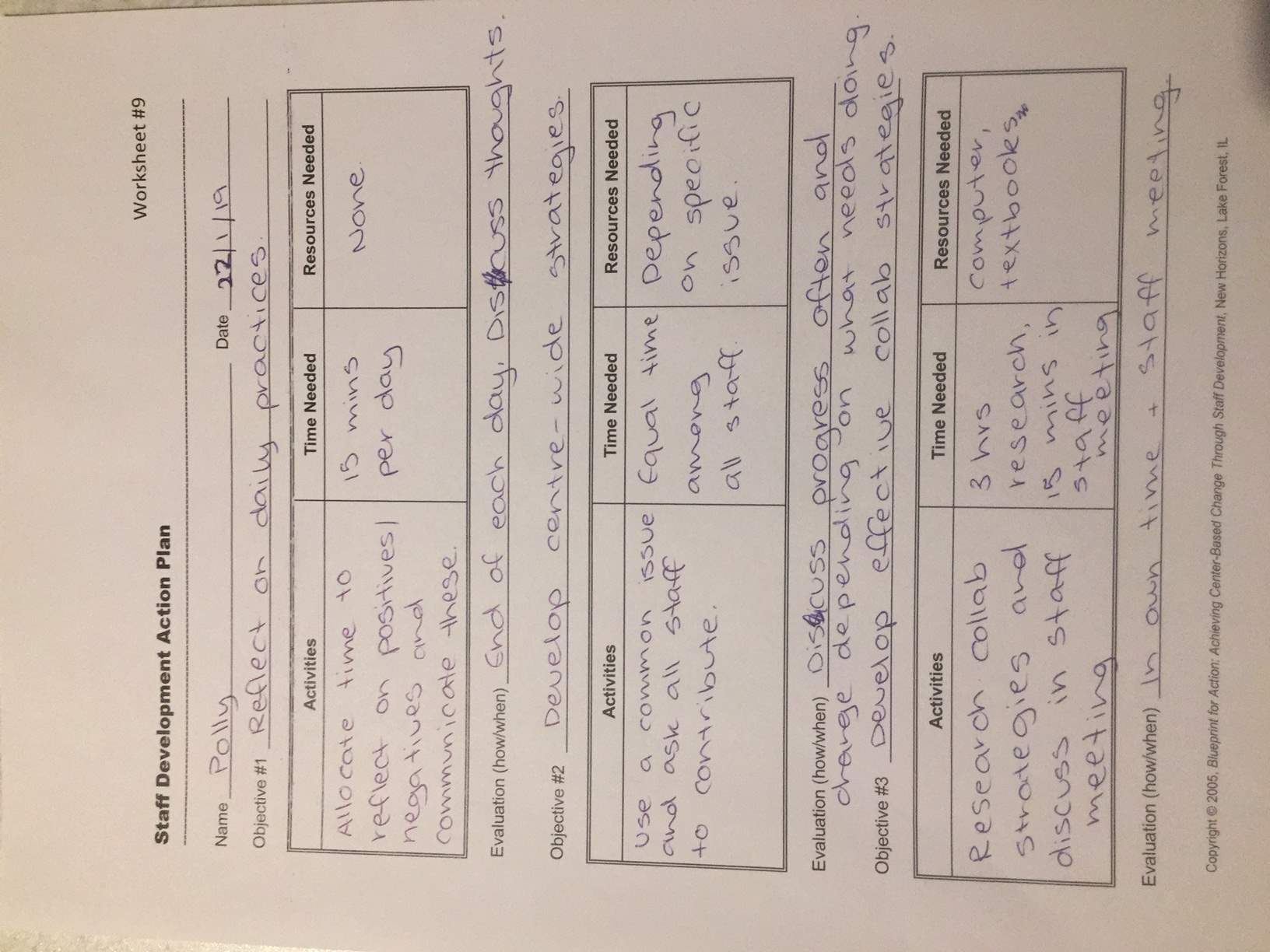

- Action Plan
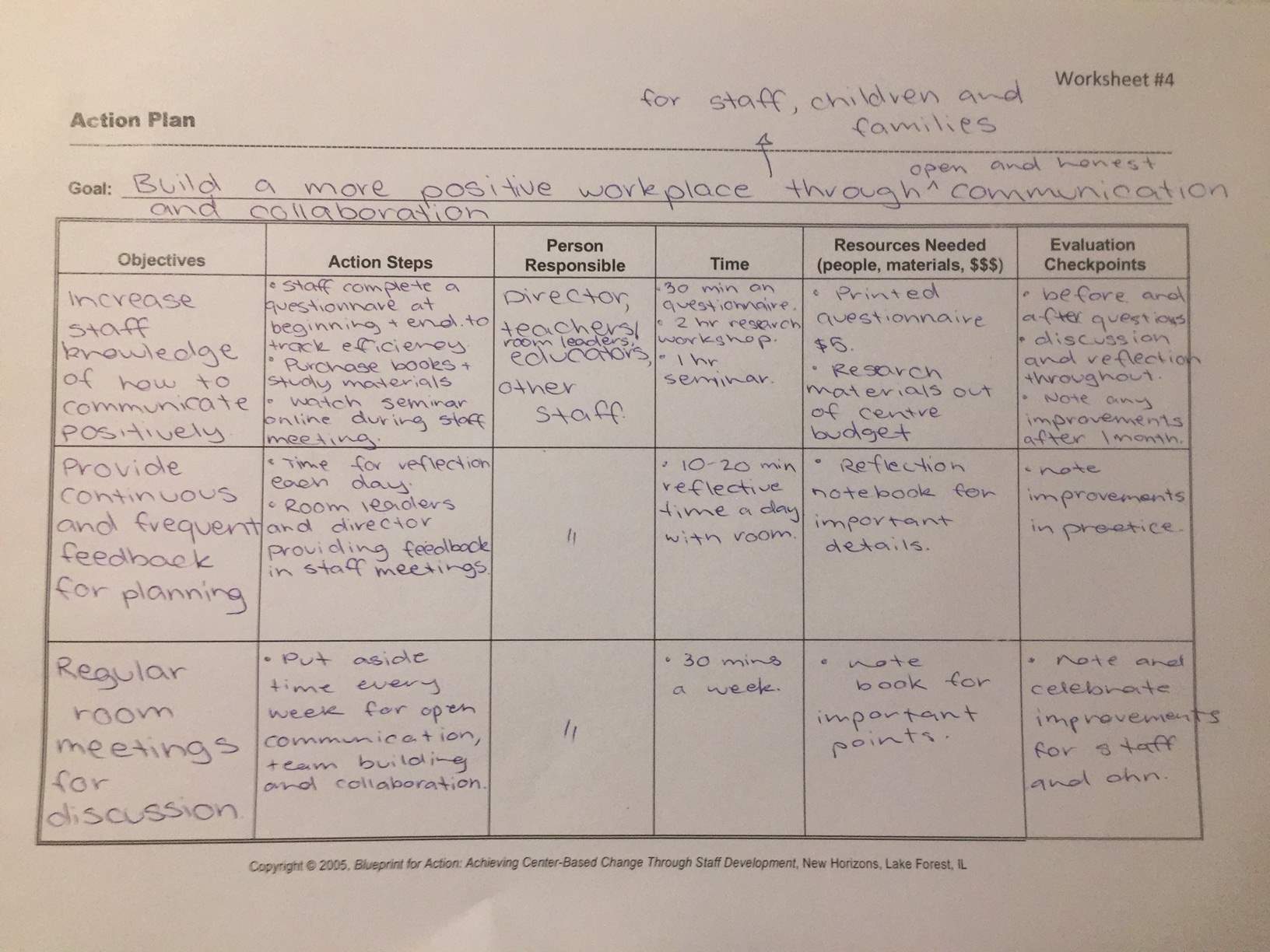
FORUM POSTS –
- Forum Post 3
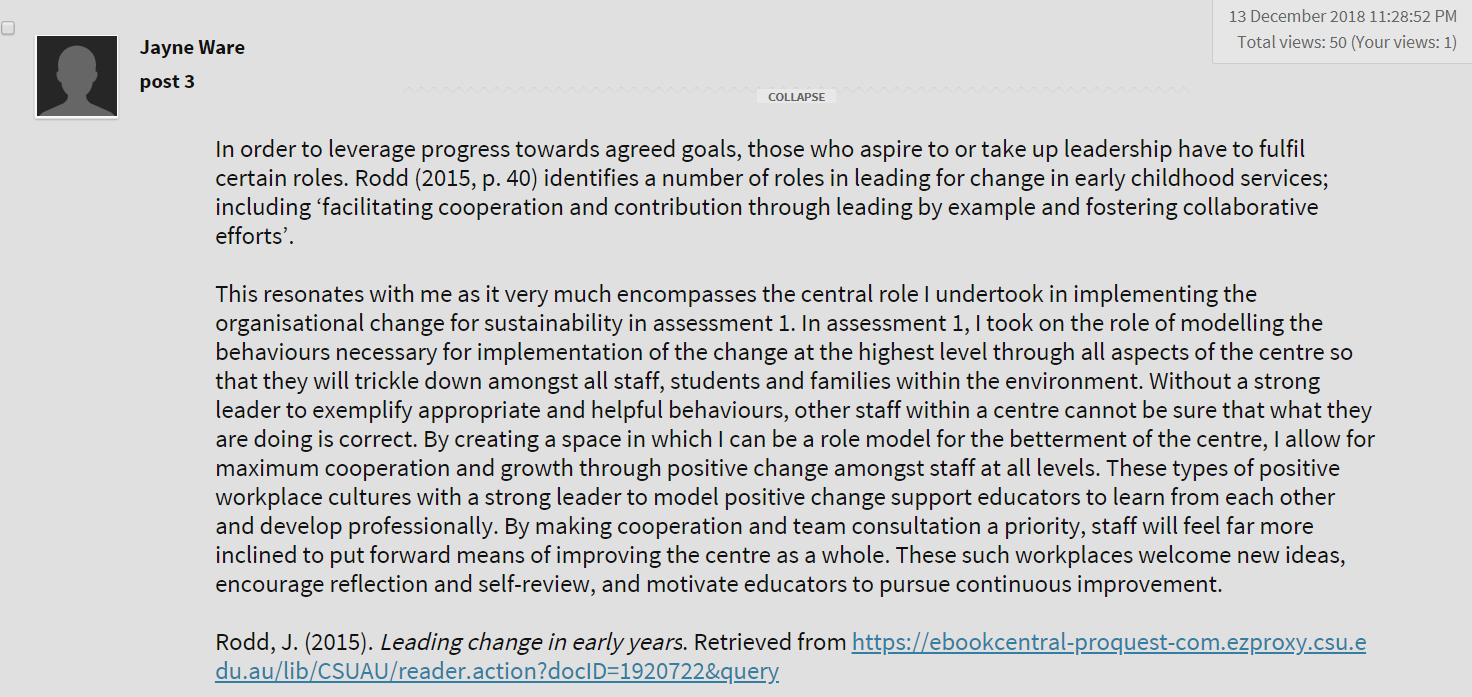
- Forum Post 4
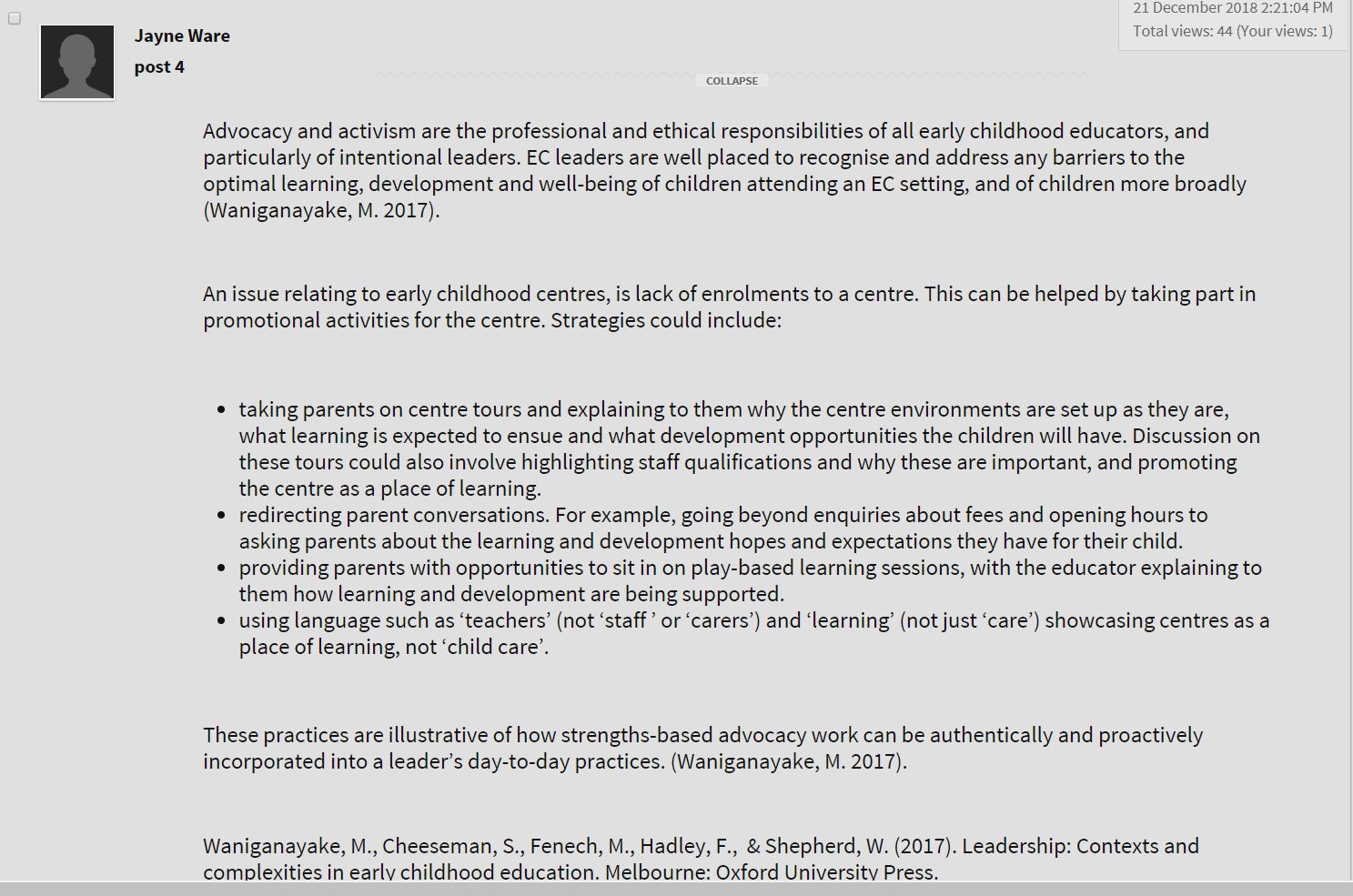
Cite This Work
To export a reference to this article please select a referencing stye below:
Related Services
View allDMCA / Removal Request
If you are the original writer of this essay and no longer wish to have your work published on UKEssays.com then please click the following link to email our support team:
Request essay removal


